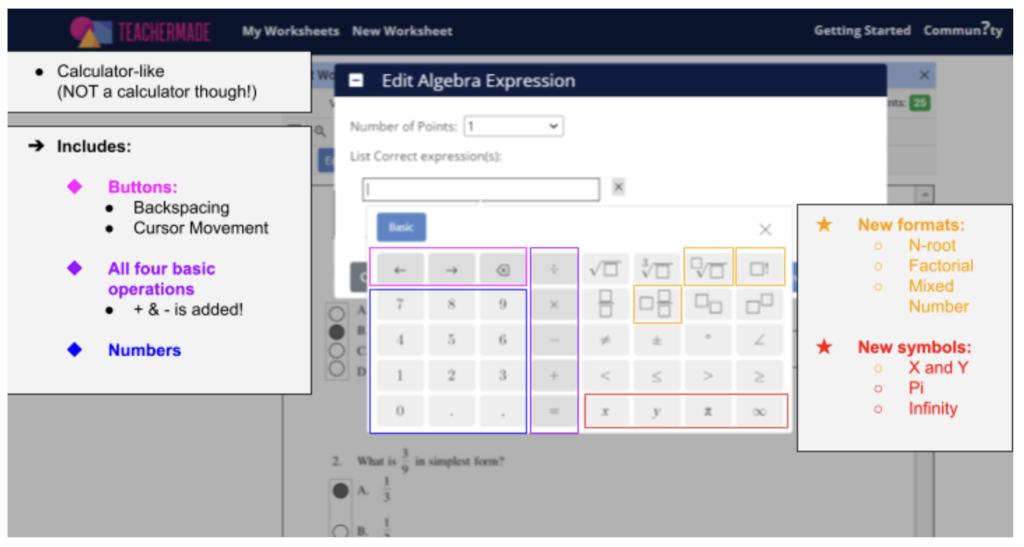Are you looking for the Classworks Special Education program from TouchMath? Click here to go to their site.
Are you looking for the Classworks Special Education program from TouchMath? Click here to go to their site.
“Show your work!” is an age-old instruction from math teachers everywhere. But the world has come a long way from copying problems off the blackboard. These days, the rise of interactive math worksheets and digital math worksheets present new mediums for teaching the problem-solving process in the math classroom.
Here, we’ll explore some of the benefits of having students show their work, and we’ll look into some technological tools that can help students show their work digitally.

Having students show their math work step-by-step is essential for you and your students. First off, it helps your students follow the problem-solving process. They can see where they’ve been, where they are, and where they’re going with the problem.
Moreover, it helps you (the teacher) see exactly what your students understand about the problem-solving process you’re teaching. It also allows you to pinpoint where a student went wrong when they get an incorrect answer. Most importantly, it highlights the common mistakes that your class makes. Once you have clear insight into these popular mistakes in the process, you can offer just-in-time feedback that anticipates the steps where students are most likely to go wrong.
There are several tips and tricks for helping students show their work that benefits their thinking and contribute to the overall learning goals. Let’s look at some strategies that help students make the most of showing their work.
Whether students are working from a textbook or a digital math worksheet, it’s essential to let them know that getting the correct answer isn’t the only measure of their success. You can scaffold these expectations throughout the course.
Start by telling them how many steps you expect them to show for each problem at the beginning of the school year. As time goes on, let them make an educated guess about how many steps each problem should have. Finally, give students the space to show their work as they please, but emphasize the key steps that they must include to receive full credit.
Once you’ve explained your expectations for showing work, you should give clear examples of what a complete answer or assignment looks like. Your example should extend beyond just formatting: you should model to the students how to show their work for each problem type.
One of the best ways to communicate expectations is with a rubric. An ideal math rubric includes measurable targets for each scale and a description of each value on the scale.
Remember those examples that you showed your class? Have the students grade these examples according to the rubric. Then, they’ll get a “view from the top” as to how you will evaluate them.
Familiarity with the expectations and execution of a rubric — especially for a multi-step problem or assignment — is a great way to promote the metacognitive and problem-solving strategies that contribute to deeper learning.
Stress the importance of showing their work for every exercise, including math bell work. It’s never too early in the semester or the class period to emphasize showing every step!
Now that your students are primed and prompted to show their work, what tools will they use to do it? Here are a few ways to have students show their work while integrating tech in the classroom.
You can elicit students’ problem-solving process by having them write the whole thing out in words. Of course, the easiest way to collect and assess their answers is digitally through an LMS or other assignment submission platform.
Why it works: When students have to explain and justify each step of the process, they’re more likely to catch their own errors. Encourage students to review the rubric before starting to promote self-monitoring throughout the activity.
Tap into students’ obsession with social media by having them share images or videos that explain their problem-solving process. You can use tools like Flipgrid or Padlet that allow students to share videos and images in real time.
Why it works: Taking a photo, shooting a video, and/or creating an image requires the students to consider their audience. They have to take a step back and make sure that they’re explaining or showing their work to make sense to their peers. This prompts them to view their thinking processes from the outside: it’s metacognition at its finest!
Gone are the days of getting called up to the blackboard and nervously solving an equation. Google Jamboard is an online whiteboard app that lets students add text and drawings to a common canvas. It’s the digital equivalent of the classroom’s whiteboard.
You can use it to elicit possible answers, show the correct steps to be taken, and/or vote on which step should come next. Basically, if you can do it on a traditional blackboard, you can do it on a Jamboard! Plus, you can save the Jamboard for later reference or review.
Why it works: Google Jamboard is great for everything from math bell work to reviewing a digital math worksheet because it allows all students to add to the whiteboard. This is a huge motivator and a great way to promote collaboration.

The new equation editor makes it easy for teachers and students to create algebraic expression items. Students can answer math equation types and add math content to their submissions. It has never been easier to make the leap to online worksheets with TeacherMade!